If you own a small, medium, or large-sized business, looking for custom software services, this article is a must-read for you. Before we discuss big data analytics, though, it is important to understand the definition of big data.
Have you ever wondered what exactly the difference between data and big data is? Both are collections of information, right? While that is true, a unique identifier for big data is its large volume. Big data is often used by businesses for obtaining customer insight. Such datasets are so extensive that traditional software like MS Excel is not agile enough to handle them anymore.
Not long ago, businesses were using traditional database methods to store quantitative information on spreadsheets like Excel; a program using grids, tables, and columns to organize the storage of data. Little did we know that the gradual inflow of data would accelerate at such a high speed that we would find ourselves in an explosion of information. It was around that time that we realized that the traditional data management systems were no longer capable of processing such massive volumes of information.
To further understand big data, let’s take a look at its three defining characteristics.
The 3Vs That Define Big Data
Volume, Velocity, and Variety are the 3Vs that best define what big data stands for.
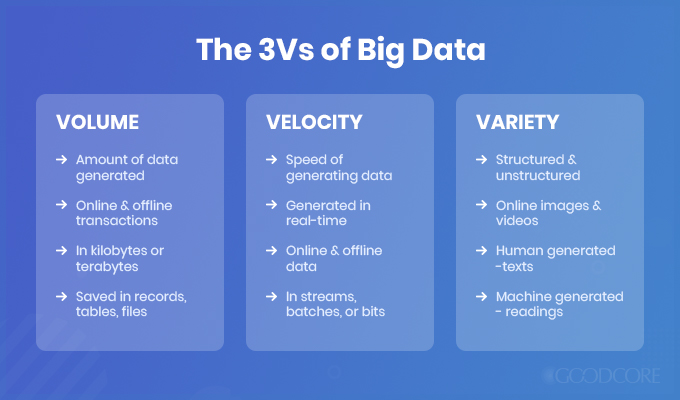
Volume
Whether or not a dataset is considered to be big data depends entirely on the volume of the information. Hence, this is the most important V defining big data. It is a simple rule: any information that is massive in volume is big data. For example, according to Fortunly, there are around 1.5 billion WhatsApp users in 180 countries! Just imagine the huge volume of data being generated on a daily basis. As traditional data management can no longer take the burden of this colossal amount of information, we rely on new methods (like Hadoop) to store and analyse the information.
Velocity
In his recent letter to Amazon shareholders, Amazon CEO Jeff Bezos emphasized how “speed matters in business.” Velocity, which refers to the high speed at which data is received, helps businesses make the most timely decisions. Tesco, Sainsbury, and Marks & Spencer are some examples of retailers using big data analytics in retail and leisure industries.
If you were the owner of a retail business, your biggest concern would be to know which items go out of stock within minutes. For retail businesses, predictive analytics is practised on a large scale, which means they predict future consumer demand with present data available. Retailers can observe customer behaviour to predict what product should be stocked in future to meet the demand.
Restocking items based on big data predictive analytics will help retailers continue with product sales. However, you will have to get your skates on to match the speed at which data is pouring in. Big data analytics tools like Apache Spark and Kafka have solutions to match the velocity of data for both real-time big data analytics and predictive data analytics.
Variety
Big data always features different varieties of data. Social media alone has a diversified range of data, such as text messages, videos, audio files, pictures, and much more. When working with big data, it is important that you organise and structure the variety of information for later analysis.
Variety of data refers to two basic categories:
- Structured Data: This can be easily defined and searched for by machine language. It is made up of quantitative information, e.g. name, address, telephone number, and billing information.
- Unstructured Data: It is unorganized in nature and is mostly text-based, e.g. emails, voicemail, ECG recordings, and business recordings.
Now that we know what big data is, it’s important to understand how big data and analytics integrate to extract value from the data. Before big data came into existence, businesses relied on basic data analytics, a traditional system to examine data for insights. With the cutting edge technology we have today, big data can be examined through big data analytics, a much faster way to draw out customer insights and behaviour patterns.
What Is Big Data Analytics?
A lot of people wonder what big data analytics is, and how it can be used to create value for their business. A simple definition of big data analytics is:
The process of examining big data for adopting appropriate business strategies and better decisions.
For example, if you were running an entertainment channel like YouTube, you would depend on big data and business analytics to answer some of the following questions:
- What kind of videos do viewers watch the most?
- How long is each video watched for?
- What are the viewer’s preferences?
- Which celebrity video is watched more?

Once we are able to obtain the answers to these questions, we can combine the powers of big data and analytics, and adopt a business strategy that would help lay out our marketing goals.
To further comprehend big data analytics, let’s take a look at its three major aspects:
- Sources of big data analytics
- Top 5 big data analytics tools
- Innovative ways companies are using big data
Sources of Big Data Analytics
Big data can be split into three wide categories on the basis of the three primary sources that it is obtained from.
1. Social Data
Social media has completely turned our lives around. Every click, tweet, and comment that we make is stored and used for the purpose of big data analytics.
Are you still wondering how that happens? Well, social data gives an insight into user behaviour patterns through various social media sites. Big data is obtained through the monitoring of how a user engages through different media channels, including Google, Facebook, LinkedIn, Instagram, and many others. The information is then processed, and relevant data is distributed to companies. So the next time you hit the like button on Facebook, bear in mind where all your information goes.
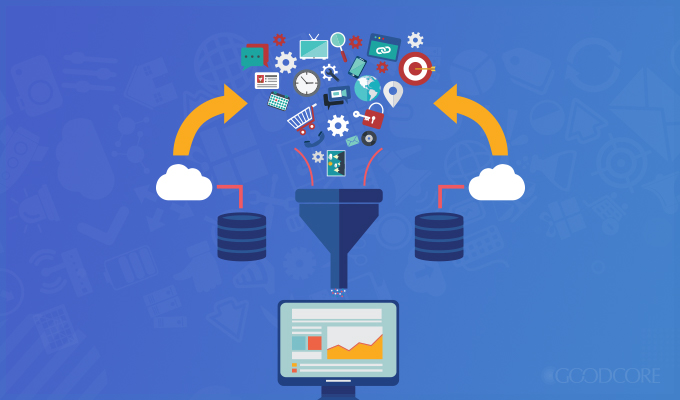
2. Machine-Generated/Internet-of-Things (IoT) Data
Machine data is composed of all the digital information that we get from software installed in devices such as road cameras, smartwatches, smart meters, and satellites. Let’s take the smartwatch, as an example. Smartwatches track an individual’s health data by monitoring their blood pressure, seizures, and steps walked on a daily basis. This data can then be used by doctors who can offer their patients with better diagnosis owing to the easy access to their consistent medical record.
3. Transactional Data:
For the owner of a retail shop, transactional data is no less than a treasure chest. A large volume of data is available to them, including:
- Purchases and returns made by the customers through payment slips
- Information about the services that customers are subscribed to
- Invoices for recording all the sales transactions and orders placed by the consumer
- Consumers’ personal information gathered through loyalty cards programs for better customer relations.
As surprising as it may sound, even a small incentive, such as a loyalty card, has a big role to play in the collection of big data. Customers are given discounts in exchange for their personal information, helping businesses to determine consumer preferences for future planning.
While all sources of big data are important, the most widely used method in the modern world is social media. Hence, it would be unfair to go ahead without shedding some light on this relationship.
Big Data Analytics and Digital Entertainment Platforms: An Unbreakable Bond
According to the Digital 2020 report, around 3.8 billion people use social media around the globe. That gives us a lot of information for big data collection! Social media channels give us an unstructured insight into consumer behaviour patterns. Here are some of the most commonly used social media platforms:

There are more than 65 social networking sites that help with big data collection. Let’s talk about two of the most popular networking sites that can help you with your marketing strategies.
Instagram is a photo-sharing platform where users make around 70 million posts every day! This makes Instagram a goldmine for business owners. Here are some ways Instagram can help improve your marketing strategies.
Targeted Advertising
Instagram is an excellent big data analytics example for targeted advertising. With the help of the infinite data inflow, Instagram extracts insights regarding user engagement and search preferences. Once all the information is processed, Instagram sells advertising opportunities to companies who are interested in specific audience types. While some businesses want to target users based on their likes, dislikes, or most shared posts, others are interested in age, gender, income, and location specifics.
Instagram Business Profile
Instagram has a unique feature of converting your normal profile to a business profile. With access to additional tools that come with the business profile, you can connect with your customers in real-time, hence making better marketing decisions.
You can also make advertisement posts directly from your business profile and monitor customer growth through their response to these posts.
YouTube
Felix Kjellberg, a 24-year-old man from Sweden, uploaded a two-minute video documenting the playthrough of a game on YouTube in 2010. Fast forward to 2021, Felix has more than 100 million subscribers on his YouTube channel ‘PewDiePie’!
It’s unbelievable how YouTube, a video-driven social media platform, can give individuals job opportunities, but what’s more impressive is how it gives businesses a platform to advertise their brands. With around 1,300,000,000 viewers, YouTube has an edge over acquiring massive data based on users’ interests. Here are some ways to start YouTube marketing for your brand.
Create Your Own YouTube channel
Next, a leading clothing brand in the UK, started a YouTube channel in 2008. As of now, it has a whopping 13,770,905 subscribers. It uploads videos of its latest trends, fashion shows, and behind-the-scenes action from their latest events.
Using Next as an inspiration, you can create brand awareness for your product(s) among large audiences. This can be done by posting videos that highlight your brand in the best way possible. You can post your advertisements on your own channel as well as YouTube-sold advertisements on other videos. By looking closely at the viewers’ reactions, you can cater to their concerns and address them accordingly.
YouTube has a comprehensive guide on how to create your own channel to promote your brand effectively.
YouTube Video Analytics
YouTube also provides YouTube video analytics, an inbuilt feature that gives a detailed overview of viewer response to the advertisements and posts that you make. It divides insights into three sections.
- Watch time reports: This focuses on the number of views for each video, consumer demographics, devices used, and more.
- Revenue reports: As the name suggests, revenue reports give an overview of the amount of income you are generating through YouTube-sold advertisements. If an ad on YouTube increases your sales, you are on the right track.
- Interaction reports: Any data that showcases viewer reaction is included in interaction reports. The numbers of subscribers, comments, likes, and dislikes are major elements of this section.
Honorary Mention: Google Analytics
Jimmy Wales, the co-founder of Wikipedia, said,
“If it isn’t on Google, it doesn’t exist”
Google is a warehouse for storing massive amounts of information. Needless to say, it is the best source for big data collection to date. Google helps in the collection of big data in a number of ways. Let’s take a look at how Google Analytics can help you in collecting big data.
Measuring Your Website’s Performance
Why is it important to measure your website’s overall performance? You, as the owner of a business, would want to build a better understanding of your consumers’ behaviour. You would want to adopt important strategies based on the understanding of your overall website performance.
Google Analytics will give you a detailed insight into your consumer behaviour pattern through its various ways for big data collection. These are some of your concerns it will cater to:
- Observing customer traffic on your webpage: How many people visit your page on a daily basis?
- The average amount of time spent on the website: The more time they spend, the more satisfied they are with the design and layout of the website.
- The time it takes for a page to load: It has been observed that the more time it takes for a user to load the page, the more reluctant they are to re-visit the page.
- User engagement on the website in terms of the number of clicks and number of pages visited: Does the buyer make purchases?
- Breaking down information about your customers demographically. Dividing the customers according to their age and gender.
- The most used device for browsing the website: Are most visits coming via mobile phones, laptops, or tablets?
These are the five most popular companies that use Google Analytics:
- Airbnb
- Uber
- Spotify
- Dropbox
To start monitoring your website performance, you can get started with Google Analytics now!
Top 5 Big Data Analytics Tools
With the huge increase in the number of internet users, big data is getting even bigger every minute. Internet users add to the size of big data through search engines, social networks, news channels, weather forecasts, and more. It is impossible to store big data with traditional methods due to their limited capacity and high cost.
The problem of analysing and storing a high volume of data has been taken care of by some big data analytics companies who have successfully built highly advanced database software for this purpose. The latest technology employed in storing massive data in software libraries/engines is cost-effective and much more reliable. For example, some tools offered by Apache Software Foundation store massive data which can be either structured or semi-structured.
Here is a list of the top 5 big data analytics tools that can help you as per your business needs.
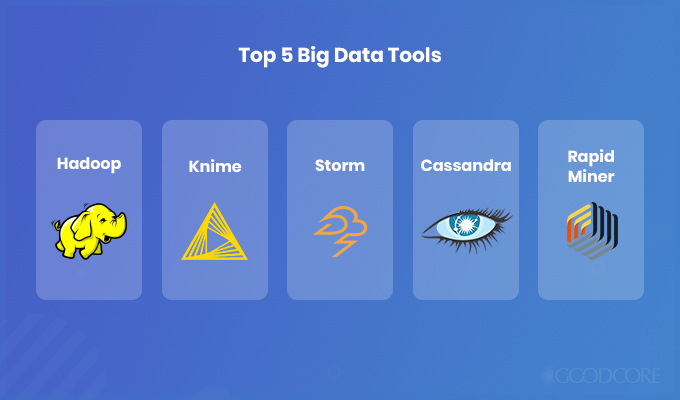
1. Apache Hadoop
Apache Hadoop is a big data analytics software tool which is specially designed for handling big data and clustered file systems. Hadoop can provide quick access to data. It has a very low cost per byte. Amazon Web Services, IBM, Intel, Microsoft, and Facebook are some of the big names that rely on Hadoop for processing their datasets.
2. KNIME
KNIME is an open-source tool known for its ease of setting up on most devices. It automates a lot of manual work. KNIME is used by companies like Johnson & Johnson for information processing and data analytics.
3. Apache Storm
Some big names such as Alibaba, Yahoo, and Groupon use Apache Storm for their business operations. It has multiple use cases which include real-time analytics, log processing, ETL, continuous computation, distributed RPC, and machine learning.
4. Apache Cassandra
This one is an open-source, free-of-cost data management system capable of handling massive amounts of data very efficiently. Companies using Cassandra include American Express, Facebook, and Yahoo.
5. Rapid Miner
Rapid Miner is known for its excellent customer service and technical support. It works with multiple operating systems and devices for machine learning, predictive analytics, data science, and big data analytics.
BMW, Samsung, and Airbus are amongst a few famous organizations using Rapid Miner.
Big data tools differ from each other in terms of cost, data storage capacity, tools, analytics, and many other features. There are innumerable big data analytics tools that you can explore. However, deciding on which tool works best for you depends entirely on your business requirements. With the right big data analytics tools processing their information, businesses can markedly improve marketing strategies by gaining valuable insights.
Innovative Ways Companies Are Using Big Data
Let’s talk about some big brands who know exactly what to do with the copious amounts of data they collect every day.
Netflix
Don’t we all stream the latest movies and TV shows on Netflix every day?
Most of us know about the trending movies that we quickly add to our watchlists, but what we don’t know is how Netflix observes our viewing habits. Big data analytics helps Netflix in monitoring user engagement through the number and type of searches made by each user. To understand which type of movie genre is demanded by each subscriber, data is used to create a detailed profile of each viewer according to their preferences. For example, Netflix knows the time and date a user watched a show, or if the viewer continues watching after pausing. Do viewers finish an entire TV show or not? The answers to all these questions help Netflix recommend movies according to the subscriber’s preferences. Over 75% of viewer activity is based on what is called the “recommendation algorithm.”
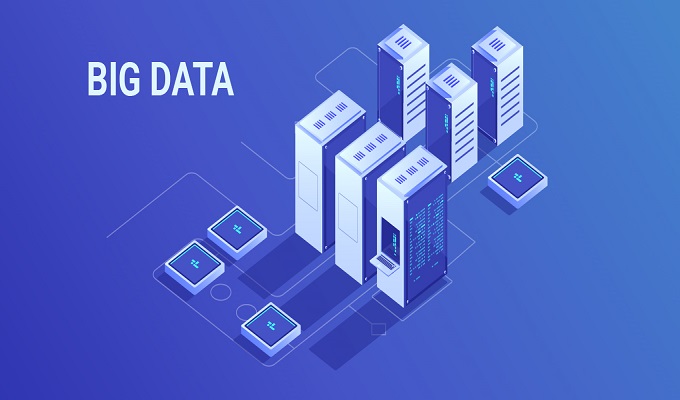
Starbucks
Have you ever wondered how Starbucks has been successfully making their consumers satisfied for many, many years? It’s not just the love of coffee but their smart strategy of analysing their data. Starbucks has a contract with a location-analytics company called Esri to keep track of the geographic distribution of its customers and their average incomes and study the traffic patterns.
These factors help them analyse if it is economically viable to open their store at a particular location. To keep the coffee lovers coming in, Starbucks goes an extra mile to obtain complete consumer information. It uses big data analytics to see consumer preferences when it comes to a new product line or the decision to retain an existing product. They have introduced a Starbucks Rewards loyalty program where customers are offered discounts in exchange for information regarding their order specifications. This data is stored and analysed, after which Starbucks makes the necessary amendments to their marketing and production campaigns.
Amazon
Gone are the days when we called a company for a complaint and had to wait hours for our information to be processed! Isn’t it a big relief nowadays, when buying a product online, all our information is auto-filled by the website at the time of checkout? Another big data analytics example is that of Amazon, one of the big four tech companies. Amazon has a large number of users. Thus, building great customer relationships is imperative for its success. With the help of big data, they acquire users’ personal information, such as names, addresses, locations etc. This information helps them in dealing with any customer query or complaint, with a faster, more effective communication system. As Amazon is famous for “shopping for everything under one roof”, it has to specifically target each customer according to their predicted preferences. Thus, much like Netflix, Amazon makes recommendations to its customers based on their interests. Instead of the user browsing through the whole range of products, the recommendation engine can point the user to exactly what they may need.
Ethical Considerations Regarding Big Data Analytics
You must have heard about the famous Facebook controversy. Cambridge Analytica, a UK-based political data analytics firm, obtained the data of 50 million Facebook users without their knowledge or consent. They used the data to analyse the geographic segmentation of Trump’s voters and build strategies for Donald Trump’s presidential campaign.
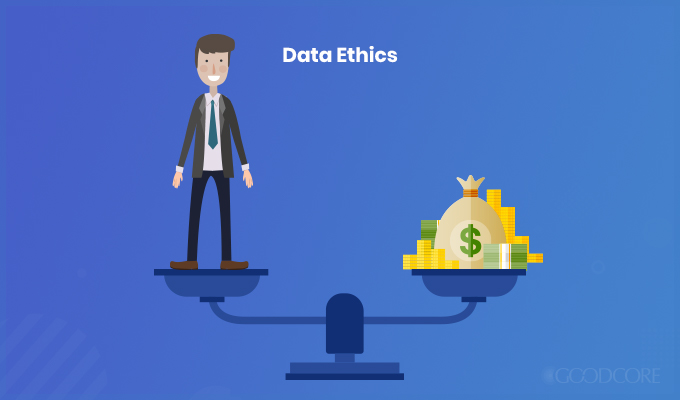
Is it ethical to obtain a user’s personal information in this manner and use it to further your own cause? Big data comes with questions regarding consumer privacy and confidentiality.
There are many companies like WhatsApp, Twitter, and Instagram who take customer consent during the signup procedure. This way, both parties know what they are getting into. However, there are some forums which sell the personal information of consumers without their permission.
If proper privacy measures are not taken into consideration, it can raise eyebrows on the credibility of big data analytics. In some countries, the government is stepping in to create a relative balance between revealing information and maintaining privacy. One example of a privacy law in the UK is a local version of the General Data Protection Regulation, called the UK-GDPR. It demands new levels of privacy rights for internet users across some countries in Europe, to protect and empower all EU citizens data privacy, and reshape the way organisations across the region approach data privacy.
Companies like Google and Apple are also stepping in to provide transparency to consumers about how their users’ data will be collected and what it will be used for. Apple uses end-to-end encryption for iMessage and FaceTime. With this feature, it gives users the utmost privacy. No one can access to users encrypted messages without their passcode.
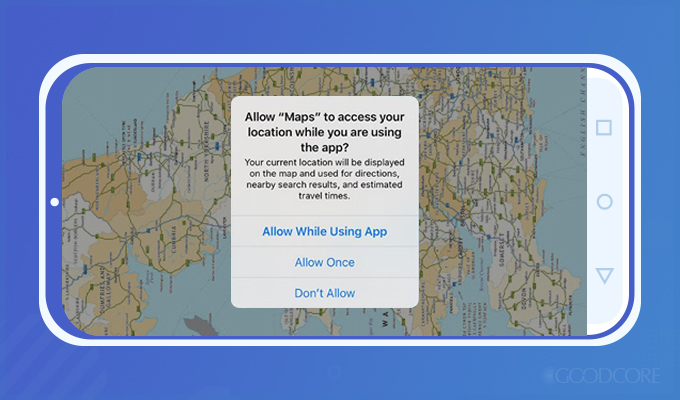
Google is following in Apple’s footsteps, adopting certain privacy protection measures for its users. For example, in Android 10, Google introduced the “Access background location” feature to better protect user privacy. This gives users the right to decide whether they want an app to access their location while running in the background.
To Sum It Up
Big data is a collection of massive data which is growing rapidly with time. It is best defined with its three Vs: massive volume, high velocity, and variety of data.
Big data sets are processed to extract valuable information to acquire insights, mainly about consumer behaviour and patterns. Valuable information is extracted with the help of big data analytics.
Big data analytics is the process of collecting, organizing and analysing data in the modern world. To make the process cost-effective and fast, companies have developed big data tools to help manage data efficiently.
With numerous big data technologies present today, businesses must choose the tools according to their requirements. Hadoop, Spark, and Cassandra are amongst the few popular tools used by companies around the world.
Once valuable information is extracted, companies use the data innovatively to make better marketing decisions.
There are numerous organisations that use big data, including the health sector, VR companies, retail businesses, banking, stock exchange, and many more. However, with the increase of internet users, social media is using big data analytics more extensively. We cannot conceive the idea of life without big data today.
Let me take off with the wise words of Peter Sondergaard, Senior Vice President, Gartner,
“Information is the oil of the 21st century, and analytics is the combustion engine.”




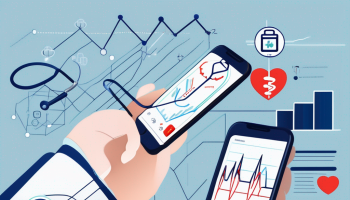

Very good explanation, thanks